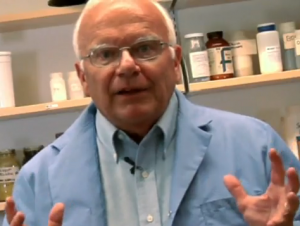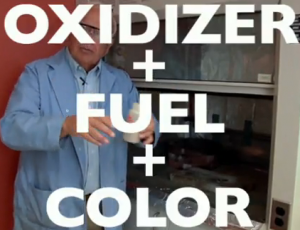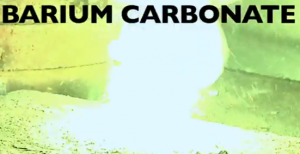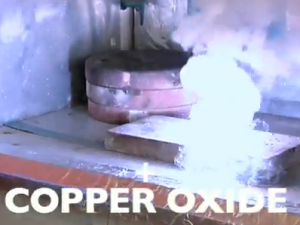This Fourth of July, you won't find anyone who loves to mix fireworks and chemistry as much as Dr John Conkling, chemistry professor at Washington College in Maryland. They are his life, and with eight energetics patents, Conkling has advised and mixed pyrotechnics for both civilians and the military. PBS producers love him, so does the camera, and he's the go-to guy for news. Watch the right hand window as he explains the chemistry of fireworks to the American Chemical Society--I'm just glad he has a safe academic outlet. If you're interested in learning more about pyrotechnic chemistry, you can attend Conklin's summer course, Specials Topics in Pyrotechnics and Explosives, July 25-29. Click here to register or to find more information.

Want some summer reading? You can Go to Amazon for a copy of his textbook Chemistry of Pyrotechnics: Basic Rules and Theory. New and used. Don't read it on the plane! Looking for like-minded pyromaniacs? There's a several-thousand-member group called the Pyrotechnic Guild, made up of private citizens who love fireworks and setting them off. Many even have small laboratories in their basements or sheds, where they do experimentation. Speaking of sheds, I'm not sure how Ted Kaczynski, the unabomber, fits into all of this. PBS's NOVA interviewed Professor Conkling (click here for the full interview): NOVA: So what's the next big thing in fireworks? Conkling: Well, even better choreography--the ability to time fireworks with music so you can match notes of music with fireworks effects. Electronic firing has let us do this, as has better quality control in the fusing of the fireworks themselves. Again, this goes along with the public's demand for really precise, spectacular entertainment.

The old way of maybe playing a musical selection and shooting some fireworks doesn't cut it anymore. When the "Star-Spangled Banner" is playing and you hear "rockets red glare," at that precise moment the public likes to see the sky explode in red. You do it five seconds before or five seconds after and they wonder "What was that for?" So you really have to match well, and we're getting really good at that. NOVA: What about spelling out letters in the sky? Conkling: The pattern shell is another recent area of innovation--the ability to have aerial fireworks burst and form a perfect heart or a five-pointed star or a smiling happy face. The next logical progression of that will be the ability to create a letter with aerial shell bursts--the pellets come out in the shape of a letter. Obviously, if you can make one letter, there's the potential to string a few letters together and spell out "NOVA" or some other word. We're not there yet. We're still a ways from it, but there's interest in being able to do that. NOVA: Does the chemistry become increasingly complex as you come up with new colors? Conkling: Color mixing is advancing. We can usually make a pretty deep red, a nice green, a reasonable blue.

Now, if you start to combine the red and the blue, you get violet, lilac, purple. There's interest in being able to make lime-green, a beautiful orange, and so on. That takes a real careful mixing of color technology. We keep getting better and better. As research continues, we're still making advancements. NOVA: What new colors should we expect down the pike? Chartreuse? Aquamarine? Hot pink?

Conkling: I think the whole palette! I see no reason why there should be much limitation on the colors we see. It's just a question of R&D effort as well as demand. It's usually driven from the entertainment side. A theme park may want a very specific effect for a show they're doing, and they'll say "Give me lime-green." Once a company starts to develop a lime-green, they start thinking, well, we have this new color, let's find some other customers who would like to have it as well. Enjoy your 4th of July.



Comments
Love it! Outside of chemical engineering and running, my other interest is music, particularly piano playing. For many years, I am known for being a good sight reader. Amazingly, a key part of music is theory which is highly analytical. My analytical side has allowed me to learn music quickly.
glad you enjoyed it!
May, I wish I could say the same--I've more often been known as a lousy sight reader! : ) (Though I'm better than I once was.)